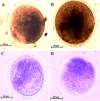Vitrification of Mouse MII Oocyte Decreases the Mitochondrial DNA Copy Number, TFAM Gene Expression and Mitochondrial Enzyme Activity
- PMID: 29201664
- PMCID: PMC5691250
Vitrification of Mouse MII Oocyte Decreases the Mitochondrial DNA Copy Number, TFAM Gene Expression and Mitochondrial Enzyme Activity
Abstract
Background: The objective of this study was determination of the changes in the reactive oxygen species (ROS) level, mitochondrial DNA (mtDNA) copy number and enzyme activity and transcription factor A (TFAM) gene expression in oocytes after vitrification.
Methods: The oocytes at metaphase II (MII) stage (n=320) were collected from super-ovulated adult female mice (n=40). These oocytes were divided into vitrified and non-vitrified groups (n=160 in each group). After vitrification of oocytes, ROS level, mtDNA copy number; TFAM gene expression and mitochondrial enzymes activity (cytochrome C oxidase and succinate dehydrogenase) were assessed and compared with non-vitrified group. Visualization of the mitochondria was done using Mitotracker green staining under confocal microscope. Data were compared by independent T-test. Values of p<0.05 were considered as statistically significant.
Results: The survival rate of oocytes after vitrification and warming was 96.05%. The intensity of cytochrome C oxidase activity, mtDNA copy number and TFAM gene expression in non-vitrified oocytes were significantly lower and the level of ROS was higher in vitrified oocytes in comparison with non-vitrified group (p<0.05). But the intensity of succinate dehydrogenase activity was not significantly different between the two groups. The pattern of mitochondrial distribution in two groups of study was similar but the intensity of Mitotracker green in non-vitrified oocytes was significantly higher than vitrified oocytes (p<0.05).
Conclusion: This study showed that vitrification of mouse MII oocytes reduced the mtDNA copy number and mitochondrial cytochrome C oxidase activity by increasing ROS level, thus the subsequent embryo development may be affected.
Keywords: Cytochrome c oxidase; Reactive oxygen species; Succinate dehydrogenase; mtDNA copy number.
Conflict of interest statement
Conflict of Interest None declared.
Figures


Similar articles
-
The mitochondrial DNA copy number, cytochrome c oxidase activity and reactive oxygen species level in metaphase II oocytes obtained from in vitro culture of cryopreserved ovarian tissue in comparison with in vivo-obtained oocyte.J Obstet Gynaecol Res. 2018 Oct;44(10):1937-1946. doi: 10.1111/jog.13747. Epub 2018 Aug 6. J Obstet Gynaecol Res. 2018. PMID: 30084218
-
Reactive oxygen species level, mitochondrial transcription factor A gene expression and succinate dehydrogenase activity in metaphase II oocytes derived from in vitro cultured vitrified mouse ovaries.Vet Res Forum. 2018 Spring;9(2):145-152. doi: 10.30466/VRF.2018.30824. Epub 2018 Jun 15. Vet Res Forum. 2018. PMID: 30065803 Free PMC article.
-
l-carnitine supplementation during vitrification of mouse germinal vesicle stage-oocytes and their subsequent in vitro maturation improves meiotic spindle configuration and mitochondrial distribution in metaphase II oocytes.Hum Reprod. 2014 Oct 10;29(10):2256-68. doi: 10.1093/humrep/deu201. Epub 2014 Aug 11. Hum Reprod. 2014. PMID: 25113843
-
Mitochondrial Distribution and ATP Content of Vitrified, In vitro Matured Mouse Oocytes.Avicenna J Med Biotechnol. 2014 Oct;6(4):210-7. Avicenna J Med Biotechnol. 2014. PMID: 25414783 Free PMC article.
-
Improved cryotolerance and developmental potential of in vitro and in vivo matured mouse oocytes by supplementing with a glutathione donor prior to vitrification.Mol Hum Reprod. 2016 Dec;22(12):867-881. doi: 10.1093/molehr/gaw059. Epub 2016 Sep 7. Mol Hum Reprod. 2016. PMID: 27604460
Cited by
-
Overexpression of Mitochondrial Genes (Mitochondrial Transcription Factor A and Cytochrome c Oxidase Subunit 1) in Mouse Metaphase II Oocytes following Vitrification via Cryotop.Iran J Med Sci. 2019 Sep;44(5):406-414. doi: 10.30476/IJMS.2019.44960. Iran J Med Sci. 2019. PMID: 31582865 Free PMC article.
-
Mitochondria Transfer from Adipose Stem Cells Improves the Developmental Potential of Cryopreserved Oocytes.Biomolecules. 2022 Jul 21;12(7):1008. doi: 10.3390/biom12071008. Biomolecules. 2022. PMID: 35883564 Free PMC article.
-
Dimethyl sulfoxide-induced DNA demethylation during vitrification of early cleavage-stage embryos and possible countermeasures.J Assist Reprod Genet. 2025 Apr;42(4):1275-1286. doi: 10.1007/s10815-025-03415-7. Epub 2025 Feb 5. J Assist Reprod Genet. 2025. PMID: 39907936 Free PMC article.
-
Melatonin Improves Parthenogenetic Development of Vitrified⁻Warmed Mouse Oocytes Potentially by Promoting G1/S Cell Cycle Progression.Int J Mol Sci. 2018 Dec 13;19(12):4029. doi: 10.3390/ijms19124029. Int J Mol Sci. 2018. PMID: 30551578 Free PMC article.
-
Melatonin improves the first cleavage of parthenogenetic embryos from vitrified-warmed mouse oocytes potentially by promoting cell cycle progression.J Anim Sci Biotechnol. 2021 Jul 16;12(1):84. doi: 10.1186/s40104-021-00605-y. J Anim Sci Biotechnol. 2021. PMID: 34266479 Free PMC article.
References
-
- Winkler-Crepaz K, Böttcher B, Toth B, Wildt L, Hofer-Tollinger S. What is new in 2017? Update on fertility preservation in cancer patients. Minerva Endocrinol. 2017;42(4):331–9. - PubMed
-
- Goldman RH, Racowsky C, Farland LV, Munné S, Ribustello L, Fox JH. Predicting the likelihood of live birth for elective oocyte cryopreservation: a counseling tool for physicians and patients. Hum Reprod. 2017;32(4):853–9. - PubMed
-
- Liu M, Zhou W, Chu D, Fu L, Sha W, Liu S, et al. A modified vitrification method reduces spindle and chromosome abnormalities. Syst Biol Reprod Med. 2017;63(3):199–205. - PubMed
LinkOut - more resources
Full Text Sources
